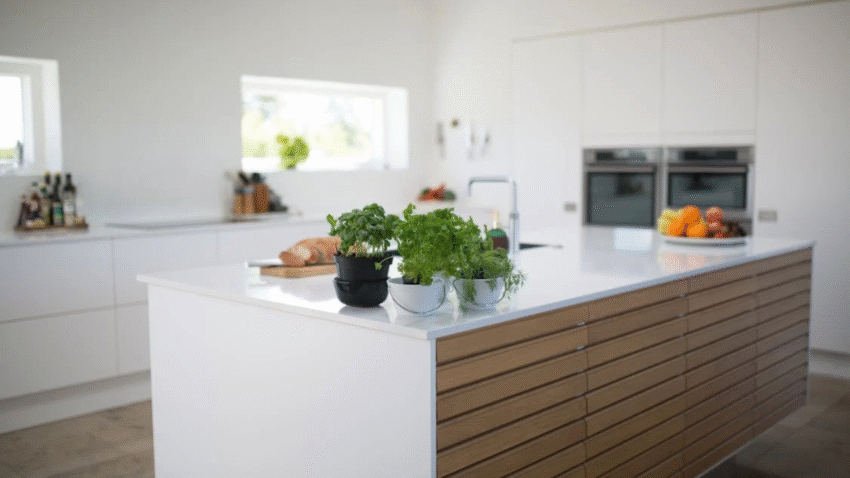Introduction
Want to bring back the shine to your kitchen countertops without damaging the surface? In this guide, you’ll learn exactly how to polish kitchen countertops safely — no matter what material you have. Whether you’re dealing with dull granite, smudged quartz, or streaky laminate, this step-by-step kitchen maintenance guide will help restore a clean, glossy finish while protecting your surfaces.
Why Polishing Kitchen Countertops Matters
Countertops are one of the most used surfaces in the kitchen — they endure daily wear from chopping, spills, heat, and cleaning products. Over time, even high-quality materials can lose their luster, develop stains, or show dull patches. Regular polishing keeps your countertops:
- Looking new and glossy
- Resistant to water, stains, and bacteria
- Easier to wipe clean
- More enjoyable to cook and prep on
Polishing also adds a layer of protection, especially for porous surfaces like granite and marble, which can absorb liquids and harbor bacteria without proper care.
Step-by-Step Guide to Polishing Kitchen Countertops Safely
Before you begin, always check the material type (granite, marble, quartz, laminate, butcher block, etc.) and use only products and techniques safe for that surface.
Step 1: Clear and Clean the Surface
Remove everything from the countertop — appliances, utensils, and décor. Wipe away loose crumbs and dust with a microfiber cloth.
Then, clean the surface thoroughly with warm water and mild dish soap using a soft sponge.
Tip: Avoid abrasive scrubbers or harsh chemical sprays that can damage the finish.
Step 2: Dry the Surface Completely
Use a clean, dry microfiber towel to wipe the countertop until no moisture remains. Polishing a damp surface can result in streaks or ineffective shine.
Kitchen Reminder: Water left on stone or wood countertops may seep in and weaken the material over time.
Step 3: Choose the Right Polish
Pick a polish designed for your specific countertop material:
- Granite/Marble: Use a pH-balanced granite polish or stone polish spray. Avoid acidic products like vinegar or lemon.
- Quartz: Choose a non-abrasive quartz polish or multipurpose stone spray. Never use wax-based polish.
- Laminate: Use a gentle, non-abrasive countertop polish or diluted vinegar and water (1:3 ratio).
- Butcher Block/Wood: Use food-safe mineral oil or a beeswax-based polish.
Pro Tip: Always test your chosen polish on a small, inconspicuous area first.
Step 4: Apply the Polish
Spray or apply a small amount of polish directly onto the surface. Use a clean microfiber cloth to rub it in with circular motions, focusing on one section at a time.
For oil-based or thicker polishes, pour a small amount on the cloth instead of the surface to avoid overapplication.
Safety Reminder: Open a window or turn on ventilation when using store-bought polishes to avoid inhaling fumes.
Step 5: Buff to Shine
Once the polish is spread evenly, use a fresh microfiber cloth to buff the surface until it gleams. This removes excess product and gives a clean, streak-free finish.
Time Saver Tip: Use a polishing pad attachment on a low-speed buffer (safe for countertops) if you’re polishing a large area.
Step 6: Let It Set (Optional)
Some products may require a short setting or curing time before placing items back on the counter. Follow manufacturer instructions if applicable.
Final Touch: Admire your sparkling countertop — your kitchen will feel instantly fresher and more refined.
Common Mistakes to Avoid
- Mistake: Using abrasive pads or scrubbers.
Solution: Stick to soft microfiber cloths to avoid scratching delicate surfaces like marble or laminate. - Mistake: Polishing over a dirty or greasy surface.
Solution: Always clean and dry the countertop before applying polish for the best results. - Mistake: Using all-purpose cleaners or vinegar on natural stone.
Solution: Use only stone-safe, pH-balanced cleaners for granite and marble to prevent etching. - Mistake: Overusing polish.
Solution: A little goes a long way. Apply a thin, even layer and buff thoroughly to avoid residue buildup. - Mistake: Polishing too frequently.
Solution: Depending on the material, polish every 1–2 months unless the manufacturer recommends otherwise.
Extra Tips & Kitchen Hacks
- Use Cutting Boards: Always use cutting boards to prevent scratches or gouges in your countertops, especially on stone or wood surfaces.
- Wipe Spills Immediately: Acidic spills like lemon juice or vinegar can etch stone or damage laminate. Clean them quickly to protect your finish.
- DIY Polish (For Laminate): Mix 1 part white vinegar with 3 parts water, plus a few drops of olive oil. Spray and buff with a soft cloth for a gentle shine.
Product Suggestion: Try “Weiman Granite & Stone Polish” for granite and marble, or “Howard Butcher Block Conditioner” for wooden countertops.
Related Task: Once your countertops are polished, it’s a great time to deep clean your backsplash or organize your countertop appliances for a complete refresh.
Conclusion
Learning how to polish kitchen countertops safely is a simple but powerful way to maintain both the look and hygiene of your cooking space. Whether you’re working with granite, laminate, quartz, or wood, the key is using the right products, techniques, and timing to restore shine without causing damage. By following this guide and avoiding common mistakes, your countertops can stay beautiful and durable for years to come.
Final Tip: Add polishing to your monthly kitchen maintenance checklist to keep your surfaces looking showroom fresh.
Bookmark this guide to bring back the shine to your kitchen anytime!
